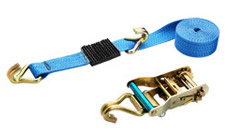
WEB SLINGS LIFTING

 SLING 7:1 NBR 15637-1
SLING 7:1 NBR 15637-1

 SLING 5:1 WHITE
SLING 5:1 WHITE

 BAND
BAND

 PIPE
PIPE

 RING 7:1 NBR 15637-1
RING 7:1 NBR 15637-1

 RING 5:1 WHITE
RING 5:1 WHITE

 LEG 4:1 NBR 15637-1
LEG 4:1 NBR 15637-1

 LEG 4:1 WHITE
LEG 4:1 WHITE

 STEEL 4:1 NBR 15637-1
STEEL 4:1 NBR 15637-1

 STEEL 4:1 WHITE
STEEL 4:1 WHITE

 ROUND SLING
ROUND SLING
 PROTECTION
PROTECTION

LOAD TIEDOWN

 What are Kits?
What are Kits?

 Load Tiedown Kits
Load Tiedown Kits

 Tensioners Tiedown
Tensioners Tiedown

 Fit up your Tiedown
Fit up your Tiedown

WHAT ARE LOAD TIEDOWN KITS?
 They are load tiedown systems or devices comprehending:
They are load tiedown systems or devices comprehending: Ratchet: traction device, that is, a tensioning mechanism for maintaining the force applied to the tiedown systems. It can be movable or fixed, the latter with a traction device mounted on the vehicle.
Terminal: final accessory that connects the tiedown sling or the ratchet to the vehicle's anchoring point, location for its fixation, which must resist to the tiedown forces being determined in function of the body type.
Flat Slings: made with high tenacity synthetic fibers to fix loads aboard the vehicles, made according to the table below.
| WIDTH | LABEL COLOR |
PRODUCT | SAFETY FACTOR |
Applicable Work Load | |
| 25mm |  |
Polypropylene | 2:1 | 200kg | 400kg |
| 35mm |  |
Polypropylene | 2:1 | 400kg | 800kg |
| 50mm |  |
Polypropylene | 2:1 | 750kg | 1.500kg |
| 50mm |  |
Polyester | 2:1 | 1.500kg | 3.000kg |
| 50mm |  |
Polyester | 2:1 | 2.00kg | 4.000kg |
| 50mm |  |
Polyester | 2:1 | 2.500kg | 5.000kg |
| 100mm |  |
Polyester | 2:1 | 5.000kg | 10.000kg |
For a safe load transportation, firstly we should compact the load to be bound, fulfilling the free spaces at the vehicle's body, using pallets, for instance, helping prevent the load from slipping.
| CMT = disruption load divided by 2 | |
| CMT = disruption capacity |
Click here and meet our Tiedown Kits
Commercial Office: Av. Jacinto Menezes Palhares, 779 - São Paulo - SP
| 55 11 3573.4500 - vendas@fitacabo.com.br



